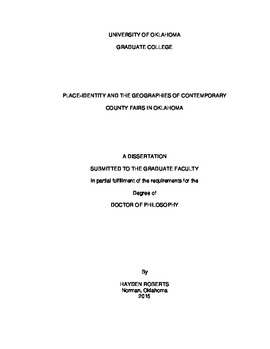| dc.description.abstract | A particular kind of allure surrounds agricultural fairs in Oklahoma. Agricultural fairs, which include county, regional, and state fairs in the United States, support emotional connections between fair participants and fair-related activities, as well as a perception of an American tradition. Aside from the midway and food vendors, most fairs continue a historic practice focused on teaching a strong work ethic and providing techniques for becoming a successful farmer in the 19th and early 20th centuries. The historic small farmer, sometimes referred to as the yeoman farmer, at one time represented an economic and social ideal. Yeoman farmers, whether male or female, may have only existed as a living tradition for a short time, but their memory and the values represented in this iconic figure continue. Agricultural fairs originally educated farmers and their families about the essentials for maintaining productive farming operations. Though these essentials have changed, many activities at the fair remain the same as a reminder of the skills associated with sustaining agriculture prior to the overly industrialized farming practices that now dominate.
The purpose of this project was to understand why county fairs continue to be an important institution in American society and why people continue to be drawn to them. An emotional tie to fairs as a particular cultural place supports ongoing efforts to sustain the vitality of these events regardless of social and economic changes that transpire in local communities or to agricultural production. Research for this study began in libraries and archives with a search into the history of agricultural fairs in Oklahoma. The research continued with an ethnographic study at three fair sites around the state: Alfalfa County in far northwestern Oklahoma, Mayes County in eastern Oklahoma, and Oklahoma County in central Oklahoma. These sites were chosen based on community size, distance to urban areas, and level of participation at the local county fair. The community’s connection to the agricultural industry was also considered. This study of Oklahoma county fairs also includes an exploration of the relationship between places and cultural identities that is a powerful part of the human condition. The bond to place helps individuals define their sense of self or identity. Aspects of identity linked to place can be termed place-identity (Tuan, 1974). Place-identity refers to an exchange of ideas and emotions between individuals and groups who develop meaning and interpretations of a place while garnering a sense of distinctiveness associated with that place. County fairs are especially intriguing to the study of place-identity because they are temporary events that happen once a year and they are not related to the way most people live. In this regard, fairs can be understood as liminal places within a ritual process based on Turner’s (1969) definition. Fairs connect to daily life through participants but are disconnected events similar to the celebration of a holiday. The vast majority of people in the United States live an urban lifestyle and earn income from professions not associated with agriculture. Yet, many of these individuals participate in their local county fair through their children’s youth activities such as 4-H or FFA, as volunteers who host the event, or as competitors in livestock or arts and craft shows.
Three objectives supported the research question behind this study of county fairs. The first objective was to collect information about the structure and value of county fairs in communities. Fair participants answered a set of questions posed about what makes fairs important. The second objective was to conduct a study of fairs in terms of their seemingly enigmatic purpose as a supporter of a nostalgic view of America’s agrarian past and a current promoter of innovation and technology in agriculture. Third, the study involved documenting fair participation as it builds personal connections or attachments to a particular place. Connection to place underlies the reasons why some cultural groups engage in certain activities. This kind of connection also becomes the basis for developing and reinforcing examples of place-identity. In this sense, county fairs are both an idea and a location, the meanings of which interpenetrate group-identity studies within a cultural geographic context. | en_US |
